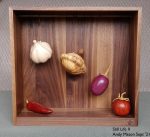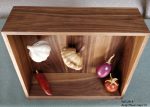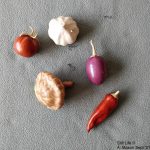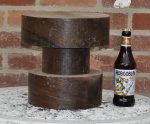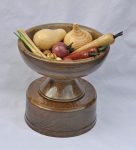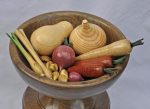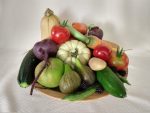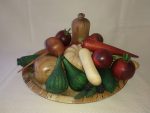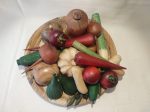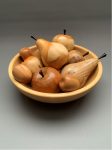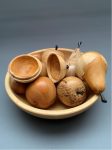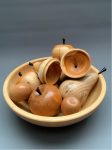Prize – £100 Voucher with Classic Hand tools. Classic Hand Tools has kindly matched our voucher of £50.
Winner – Andy Mason
Andy Mason
Entry Name: Still Life II after Juan Sánchez Cotán
The inspiration for this work is the paintings by the Spanish still life painter Juan Sánchez Cotán (1560 – 1627). I had previously made one depicting fruit, but this time I chose vegetables. I also decided to use only the natural colour of the wood, so apart from a few pyrography dots in the base of the garlic to suggest the root, I have not used paint or stains in this work. The pieces are finished with sanding sealer and wax polish.
The woods are as follows:
Garlic: Hornbeam
Pattypan squash: Spalted Beech, Elm
Aubergine: Purpleheart, Robinia
Tomato: Padauk, Box
Chili Pepper: Padauk, Box
The display box is Walnut, and the hangers are made from earring wire and thin fishing line.
Steven Fearnley
This trophy was made for a horticultural society, commissioned by a son in memory of his father, who loved growing vegetables. No inscription was added, as the society intended putting engraving plaques around the plinth.
The trophy itself was made from three walnut blanks, all approximately 4 inches tall. The picture with the beer bottle indicates the overall size, which is 11 inches in diameter, 12 inches tall. The spigots and recesses used hold the pieces for turning became mortice and tenon joints, and they were screwed together with double ended dowel screws, rather than glued.
Once the trophy was made, it was filled with vegetables. The natural colour of different wood was used to reflect the colour of the vegetables, apart from a touch of green Chestnut spirit stain on the stalk of the spring onion. Padauk was used for the carrots, being the closest to orange of the timbers I have. Larch gave the rings on the onion, as well as being a suitable colour; purple heart was an obvious choice for the beetroot and the radish; spalted beech was used for a butternut squash, and some button mushrooms; laburnum was used for a couple of darker mushrooms; box for some shallots, oak for the parsnip and beech for the spring onions. The trimmed leaves seen at horticultural shows were made from leather strips, dyed green with spirit stain. The string used to tie up the top of the onion was turned at the same time as the onion. It was agreed with the customer that the pieces would be left loose in the cup, rather than glued in place. An opportunity for people at the show to pick the pieces up and have a closer look.
The cup and vegetables were given a coat of cellulose sanding sealer, then finished with three coats of wax – Tripoli, white diamond, and finally carnauba. All applied using the Beall three-mop buffing system. This leaves a high sheen finish.
Dave Wraight
I have a big garden and grow lots of fruit and vegetables. The first photo shows some of the harvest from my own garden in the second week of September. This platter of fruit and vegetables is the inspiration for my entry into the Month of Harvest competition. The spalted beech platter is about 14 inches in diameter and one and a half inches deep.
I’ve often turned apples and pears with the occasional plum but have never really thought about turning vegetables so this is a first for me.
The largest vegetables are the two different winter squash – butternut and dumpy. The butternut squash is turned from apple wood – taken from a tree in my garden. The dumpy squash is turned from a piece of horse chestnut. The dumpy squash has been carved to give it the correct shape. These two veg are all-natural colour apart from some green felt tip stripes on the butternut. The green colouring on the other vegetables is from a green ink or in the case of the leeks diluted green ink. The courgette and cucumber have been turned from some light-coloured European oak. The courgette has flat sides which have been shaped on a sanding disc. The cucumber is a small variety but this one has actually grown a little large! The leeks were also made from oak and coloured. Carrots and tomatoes were turned from padauk and the tomato tops made from horse chestnut then carved and coloured. This year Is the second year I have grown potatoes and the variety is long and narrow with some shaping at the ends so the two potatoes were turned on different centres to get the little lump at the end. (More horse chestnut). The beetroot was turned from sapele trying to achieve some natural colouring from the wood. I have had a good fig harvest this year and these were the last two to ripen. More green ink, some carving and sanding to try to achieve the right appearance. The French beans were turned, then the ends shaped with a rasp before adding some colour. I pondered long on whether to include the blackberries but some 60 small beads of box were turned (using a fluted chisel), then coloured black (Indian ink) and glued together. The first blackberry is now somewhere in the shavings never to be seen again but the second and third survived and now have a place on the platter.
All the vegetables have been finished with oil and then buffed on the wheel mop.
Like my fruit and vegetables which have zero food miles, most of the wood I have used is from close to home, the sapele has been recycled, the padauk came from a local sale and the ink is left over from colouring Xmas trees.
All the original fruit and vegetables have now been eaten and though I say it myself they were good eating!
Graham Brooks
My offering this month is a bowl of seasonal fruit, containing apples, pears and plums. The pieces vary in size but the overall size of the bowl is approximately 250mm diameter by 80mm deep. One apples and one pear are in the form of boxes each with hand chased threads to the joints.
The apples and pears were turned from Yew or Spalted Beech with African Blackwood stalks and a clove at the base. The plums were turned from wood from a Damson tree cut down in my garden some years ago. The bowl was turned from Sycamore.
The external finish on the fruit is sanding sealer followed by three stage buffing system. The interior of the boxes are finished with microcrystalline wax. The interior of the bowl is finished with Chestnuts food safe oil and the exterior with Chestnuts finishing oil.
The ‘box’ fruit was held in a 4 jaw chuck to allow hollowing and thread chasing, the threaded joint and one chucking point were then used to hold the piece whilst on end was finished. A thread was then formed in a scrap piece to hold the remaining part of the box whilst the final chucking point was removed and the end shaped. The other apples and pears were held using a 4 jaw chuck to hold the piece whilst the widest end was turned to shape and a hole drilled to accept a homemade screw chuck, which the piece was reversed onto to complete the turning. A second hole was drilled to accept the stalk or clove. The plums were held in a 4 jaw chuck and turned to shape then parted off at the base with a skew chisel. The groove in the side of the plums were carved using a Sabertooth burr in a micro motor and finished with hand sanding.

